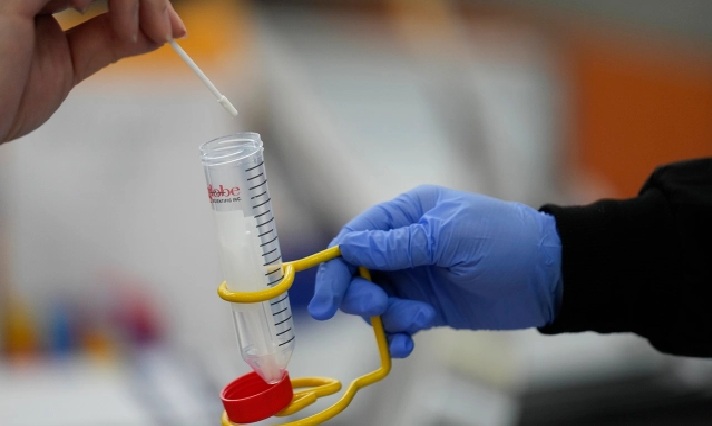Joseph Choi
The XBB.1.5 omicron subvariant is raising concerns of a potential surge in COVID-19 cases as it sweeps across the Northeast.
Officials have warned in recent weeks that the strain is highly transmissible, can more easily evade the immunity offered by vaccines or prior infections than past variants — and is likely to drive cases up around the country.
The subvariant has already rapidly spread in the Northeast, where it is currently estimated to be causing about 72 percent of infections.
Data from the Centers for Disease Control and Prevention indicated last week that XBB.1.5 was the most prevalent subvariant in the U.S. as a whole, accounting for 40.5 percent of cases in the country. However, this information is subject to change as more data is collected from states, and XBB.1.5’s share of U.S. cases has fallen to an estimated 27.6 percent as of Friday.
But while another omicron subvariant, BQ.1.1, is still dominant in the country beyond the Northeast, XBB.1.5 has also reached all other regions of the U.S., and officials predict it will continue to spread. Due to its recent ascent, data on XBB.1.5 is limited, but health officials have disclosed some key insights into the strain, as well as what questions remain unanswered.
Here is what know about XBB.1.5:
‘Most transmissible’ omicron subvariant so far
??XBB.1.5 is “the most transmissible subvariant that has been detected yet” of the already highly contagious omicron strain, Maria Van Kerkhove, technical lead of the World Health Organization’s (WHO) COVID-19 response, said in a recent briefing.
Van Kerkhove attributed the subvariant’s high transmissibility to the mutations it carries allowing it to “adhere to the cell and replicate easily.”
Ashish Jha, the White House’s COVID-19 response coordinator, concurred with Van Kerkhove’s assessment, saying on Twitter that XBB.1.5 was most likely more able to evade immunity than previous omicron subvariants.
People who have not recently been infected with COVID-19 or vaccinated against it probably have “very little protection against infection” caused by XBB.1.5, Jha further advised.
Cases are expected to rise
The northeastern regions of the country have already seen a recent rise in cases, according to data from the Department of Health and Human Services. Hospitalizations in these areas have also risen between 10 and 15 percent, though it remains to be seen if XBB.1.5 causes more severe illness than previous subvariants and is behind this jump.
Food and Drug Administration Commissioner Robert Califf said when speaking about XBB.1.5 this week that he expected a further increase in cases.
“The XBB variant and its related variants (XBB.1 & XBB.1.5) are sweeping through the Northeast and will likely move to other regions quickly,” he tweeted.
But Califf noted that the cases caused by XBB.1.5 and other new variants don’t appear to be more serious than those caused by past strains of the virus.
“At this point, we’re experiencing an increase in cases with no evidence of increased severity of illness related to these variants,” he said.
Van Kerkhove echoed Califf’s forecast, saying, “We do expect further waves of infection around the world.”
“But,” she added, “that doesn’t have to translate to further waves of death, because our countermeasures continue to work.”
First detected in the US before spreading globally
While XBB, the subvariant from which XBB.1.5 descends, was initially detected in India, the latter mutation is believed to have first been identified in the U.S. in October.
It has since been detected in 29 other countries, according to the WHO. Roughly a dozen countries in the European Union alone have detected XBB.1.5, though levels of the subvariant remain low there, according to the European Centre for Disease Prevention and Control.
It’s a recombinant virus. What does that mean?
XBB.1.5 is considered a recombinant virus, meaning it carries genetic data from two previous viral mutations.
The subvariant is descended from XBB, which in turn has genetic data from two viral strains that descended from the BA.2 “stealth” subvariant. That strain, characterized by its mutations that made it difficult to track with PCR tests, was the most prevalent in the U.S. in early 2022 before being overtaken by two other omicron subvariants, BA.4 and BA.5.
Treatments and vaccines likely still effective
Countermeasures are currently still expected to be effective at treating COVID-19 infections caused by XBB.1.5 and reducing the severity of illness, as Van Kerkhove said.
Jha said the updated bivalent COVID-19 booster is still the “best protection” against infection and severe illness.
Califf noted that while that booster has been observed to be less effective in neutralizing against the XBB strain when compared to the ancestral strain, the neutralization it offered was still strong enough to provide “some degree of protection.”
Columbia University researchers found in an early preprint study that subvariants descended from the BQ and XBB lines are better than previous strains at evading neutralizing antibodies. Neutralizing antibodies, which can be gained through prior infections or vaccination, stop infections by binding to viruses and blocking them from attaching to cells.
Mutations and changes to the SARS-CoV-2 virus can make it harder for neutralizing antibodies to recognize and detect the virus when it enters a person’s system, enabling the virus to evade an immune response that could have otherwise stopped it from causing infection.
But the researchers noted that vaccines have still been shown to be effective against such strains.
“It is important to emphasize that although infections may now be more likely, COVID-19 vaccines have been shown to remain effective at preventing hospitalization and severe disease even against Omicron as well as possibly reducing the risk of post-acute sequelae of COVID-19 (PASC or long COVID),” they said.
Oral antivirals like Paxlovid and molnupiravir are also still expected to be effective against XBB.1.5, as they don’t function by boosting antibodies — which the strain appears better able to evade — but by hindering the virus’s ability to replicate itself.
Courtesy: thehill







